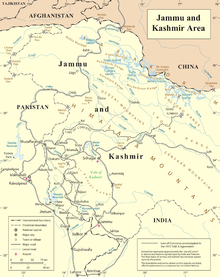Hunza River
This article needs additional citations for verification. (May 2013) |



Hunza River (Urdu: دریائے ہنزہ) is the principal river of Hunza in Gilgit–Baltistan, Azad Kashmir, Pakistan . It is formed by the confluence of the Kilik and Khunjerab nalas (gorges) which are fed by glaciers. It is joined by the Gilgit River and the Naltar River before it flows into the Indus River.
The river cuts through the Karakoram range, flowing from north to south. The Karakoram Highway (KKH) crosses the Hunza River near Hunza and Nagar valleys.
The river is dammed for part of its route.[1]
In January 2010, the Attabad landslide disaster in January 2010 completely blocked the Hunza Valley. A new lake — now called the Attabad Lake or Gojal Lake — [2] which extends 30 kilometers and rose to a depth of 400 feet, was formed as the Hunza River backed-up.[3] The landslide completely covered sections of the Karakoram Highway.[3]
See also
References
- ^ "Pictorial – Some spectacular photographs of the dammed Hunza River". Pamir Times. Retrieved 27 May 2013.
- ^ "Gojal Lake Hazard", Pamir Times, Islamabad, 21 July 2015
- ^ a b Michael Bopp; Judie Bopp (May 2013). "Needed: a second green revolution in Hunza" (PDF). HiMaT. p. 4. Retrieved 26 November 2015. Karakorum Area Development Organization (KADO), Aliabad
External links
![]() Media related to Hunza River at Wikimedia Commons
Media related to Hunza River at Wikimedia Commons
35°55′N 74°22′E / 35.917°N 74.367°E
